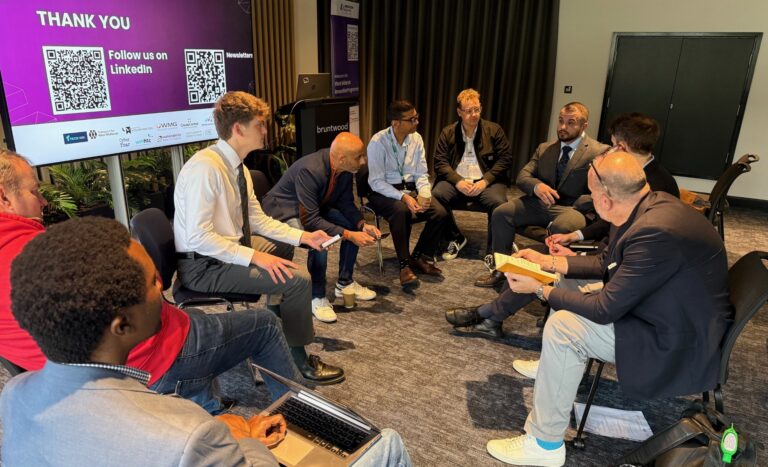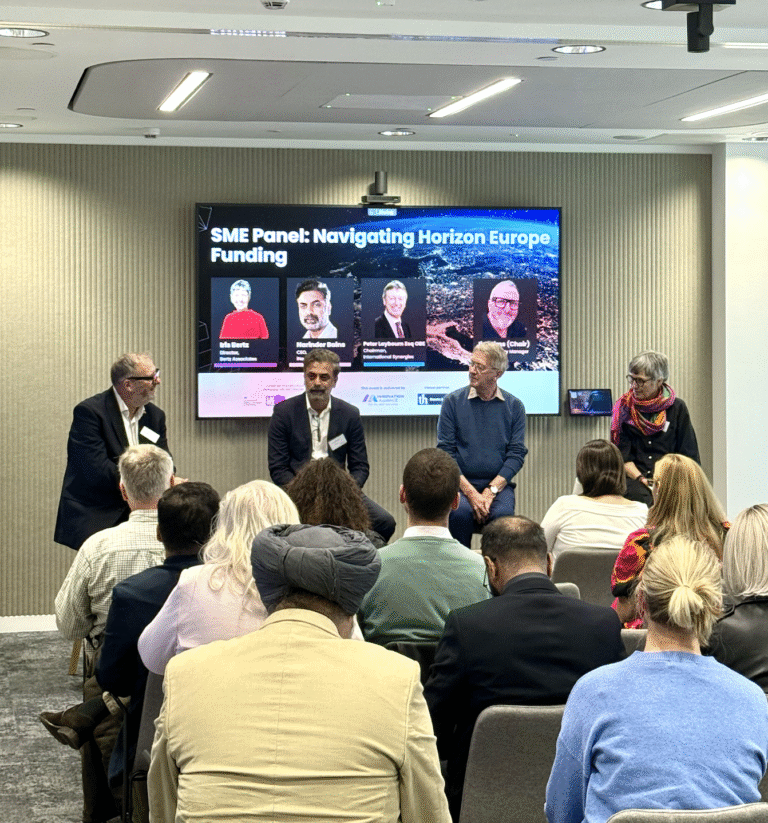An important part of the innovation ecosystem is how larger companies can draw upon the innovative potential of SMEs, and how SMEs can best use larger companies as early adopters and routes to market to mutual benefit. Our recent Policy and Practice Breakfast on the 19th of September discussed such collaboration, whereby instead of competing with the giants of the industry, valuable relationships can be forged in order to overcome industrial challenges.
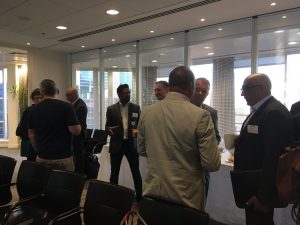
The event brought together people from a variety of organisations – of different sizes and sectors – to discuss the importance of fostering these relationships, and invited representatives from National Express and Capgemini to share their experiences and insights into what we should be doing, how we should be doing it and why it is necessary. The question this workshop posed specifically was: How can we enhance engagement between SMEs and larger businesses? Asking for examples of when such engagement was successful.
Capgemini is a global leader in consulting, technology services and digital transformation. In order to cope with the paradigm shifts that are occurring in business today, their Applied Innovation Exchange(AIE) model is designed to enable enterprises to discover relevant innovations to experiment with in their specific industry. Stuart Fleming, VP of Cloud Infrastructure Services, Projects and Consulting, used Cisco as an example to describe the out-dated innovation models that were often used to stimulate these collaborations. Their incubator model, he explained, was no longer effective in todays’ market – the focus instead needed to be on demand-led innovation.The question, therefore, was how could they start to help their customers identify that innovation?
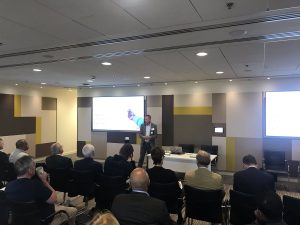
Capgemini use AIE in order to work with their companies to gain MVP (minimum viable product) and POC (proof of concept). He explained how AIE “embraces the art of the possible” and brings solutions to life through rapid development of digital products, services and experiences. It is devised into 4 principal stages:
- Discover – What do you want to achieve?
- Devise – What is the proof of value?
- Deploy –How do we come up with an MVP? How do we make sure it will work?
- Sustain – How do we make it the next best thing? How will it evolve?
The example he drew upon was the use of fish trackingnear Heathrow Airport. Surrounded by rivers, Heathrow were worried about the sustainability and environmental issues stimulated by the development of Runway 3, which was going to involve significant re-routing. The ‘problem’ therefore, was what were they going to do with the fish?In just 6 weeks, the solution had been implemented – Capgemini put cameras in the rivers to track the fish, in order to test whether the river disruption was going to affect the fish’s route.
National Express, a leading international public transport operator, demonstrate a slightly different approach to attracting and engaging with these innovations. Rob Muir, Chief Digital Officer – responsible for setting digital strategy and ensuring its implemented – described the increasing need for innovation in the transport sector due to its’ constantly evolving nature, revealing more and more fresh challenges all the time. He emphasised that working as a team with small businesses to respond to these challenges is the culture they’re trying to create, and the way of thinking they’re trying to embed. However, instead of simply “chancing upon a better business”, they wanted to get rid of the nuances and create a clear framework and repeatable structure.
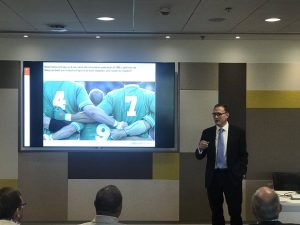
They set up Innovation Programmes in their main hubs (one in iCentrum in Birmingham, the others in Madrid and Chicago) – each working as a different model in order to test which structure was more effective. In the UK, they tested NXIS (National Express Innovation and Science), a “deliberately boring name” to signify low risk (the importance of language was discussed at length throughout the morning). The strategy had three legs:
- Working with Universities (long-term)
- Internal Innovation (setting up processes where they force themselves to think more laterally and internally)
- Engaging with companies outside National Express
They ran a pitch process, giving companies a 15-minute slot to present to a room full of stakeholders, for the intended consequence of “getting on with it” and enabling the stakeholders to see all of the potential solutions. However, a welcome unintended consequence of the event was giving these companies access to all of the decision makers at one time; “it gave velocity to it”. Indeed, a huge problem for SMEs, Rob explained, is that large companies throttle them with procurement processes – the engagement process can turn into months before it moves on, which can be a serious problem for new businesses. Therefore, it was realised that the best way to engage with small companies was to create a forum that allows all decision makers to hear it at the same time.
The presentations invited fruitful discussion and a diverse range of intuitive questions from the audience. Amongst the topics discussed was the importance of ensuring the small companies maintained their own identity whilst receiving valuable support and creating something viable. As Stuart outlined, the underlying principle of these collaborations was that it is a “win win” situation; the larger companies need to ensure that value will be achieved through the investment, whilst the smaller companies want to resist getting swallowed up by these big organisations. Ensuring they maintained their individual identity, however, was often just as essential for the large companies – “it helps us track the progress of the projects”, Rob explained.
An area often over-looked and under exploited is the idea of cross-sector innovation. IAWM Director Pam Waddell questioned the structure of the networks and the possibility of gaining valuable access to innovations in different sectors. Andrew Mair (Midlands Aerospace Alliance) pointed out the valuable collaborations made between the aerospace and health sector once their perhaps less obvious similarities were recognised. However, achieving this to a beneficial degree was often difficult; the focus on “innovation” often makes it hard to engage with SMEs across alternative sectors. Rob expressed that there was a difficulty in simply connecting with all the innovative businesses in the first place, before you look at the different people with varying agendas.
There are obvious challenges to fostering these relationships. Amongst those specified was time, focus, the continuous temptation to ‘buy big’, resource, and commitment. However, the event highlighted the immeasurable value that forging and fostering these relationships can bring. The fascinating insights from two very different perspectives allowed for a broad understanding of how companies operate and manage these various relationships, working together in mutually beneficial partnerships to achieve these innovative solutions.
(Author: Rhiannon Davies, Innovation Alliance for the West Midlands)


